Chinese vs US Docs: Comparing Burnout and Lifestyle
Comparing Chinese and US Physicians on Lifestyle and Burnout
In an interesting collaboration, Medscape shared the questions in its 2013 lifestyle and burnout survey with DXY (www.dxy.cn), which is China's largest online academic portal for physicians and life-science professionals. DXY was established in 2000 and currently has over 3 million registered members and average daily page views of 1.8 million. In this comparison, Medscape and DXY sought to identify differences in how US and Chinese physicians perceive their lifestyles and their experience of burnout.
The first interesting observation to emerge was the large proportion of younger physicians who responded to the DXY survey. Only about 6% of the approximately 6000 Chinese respondents were over age 45. This higher rate of younger physicians is the result of major expansion in Chinese college/university enrollment since 1998, producing dramatic growth in the number of certified Chinese physicians over the past decade. In order to make a reasonable comparison with the Medscape survey results, then, only US physician respondents younger than age 45 were included in the analysis, which totaled about 7500.
There was also a challenge in comparing specialties; a third of the respondents to the DXY survey reported that they were involved in Chinese traditional medicine or a mix with standard medicine. Another 24.1% said that they were internists. The assumption was that these groups taken together would be considered primary care, for a total of 57%. On the US side, a quarter of the respondents reported being family physicians (12%) or general internists (13%). The remainder practiced in subspecialty areas. There was also a slight difference in the proportion of men and women: 32% of Chinese respondents were women compared with 41% of US respondents.
Burnout and Its Causes
Major differences exist between the 2 physician populations in their responses to the questions about burnout. Both groups were given the same definition: "Do you suffer from burnout, defined as loss of enthusiasm for work, feelings of cynicism, and a low sense of personal accomplishment?" Of those who responded, 82% of Chinese physicians said that they were burned out compared with 42% of US physicians.
Burnout Severity
In regard to the severity of burnout, it was difficult to compare the responses because the questions were phrased differently. US physicians were asked to rate their burnout on a scale of 1 to 7, where 1 = "it does not interfere with my life" and 7 = "it is so severe that I am thinking of leaving medicine altogether." Their responses, with a mean of 3.65, were as follows:
• 1 (6%)
• 2 (19%)
• 3 (24%)
• 4 (21%)
• 5 (17%)
• 6 (7%)
• 7 (5%)
Chinese respondents were given 4 options to choose from:
• It is manageable and I'm not making any changes (36%)
• It is manageable but I need to make some changes in hours/workload/etc. (52.2%)
• I am thinking of leaving my current position (7.3%)
• I am thinking of leaving medicine altogether (4.5%)
We somewhat arbitrarily matched up the answer options:
US options 1 and 2 = Chinese option 1
US options 3-5 = Chinese option 2
US option 6 = Chinese option 3
US option 7 = Chinese option 4
We then created a table that offered a rough comparison (Table 1). The percentages indicate that although burnout rate is extremely high in China, few Chinese (and US, for that matter) physicians are planning on making any major changes.
Table 1. Severity of Burnout
| Options | Chinese | US |
|---|---|---|
| It is manageable and I'm not making any changes | 36% | 25% |
| It is manageable but I need to make some changes in hours/workload/etc. | 52.2% | 62% |
| I am thinking of leaving my current position | 7.3% | 7% |
| I am thinking of leaving medicine altogether | 4.5% | 5% |
Causes of Burnout
When asked about the top causes of burnout, again the questions were posed differently, with US physicians asked to rank each stressor on a score of 1 to 7, where 1 = very unimportant and 7 = extremely important. Chinese physicians were given the same options but were asked to choose the top 5 and rank them in order from most to least important. The Chinese survey also excluded 3 options. Therefore, instead of providing numeric values, Table 2 simply lists the most to the least significant stressors for each group, according to the results of each survey. Insufficient income is the number-one stressor for Chinese physicians, and long hours at work are important causes of burnout for both groups.
Table 2. Causes of Burnout for US and Chinese Physicians, Ranked Most to Least Important
| United States | China |
|---|---|
| Too many bureaucratic tasks* | Income not high enough |
| Spending too many hours at work | Spending too many hours at work |
| Income not high enough | Lack of professional fulfillment |
| Feeling like just a cog in the wheel* | Too many difficult patients |
| Too many difficult patients | Inability to provide patients with the quality care they need |
| Lack of professional fulfillment | Compassion fatigue (overexposure to death, violence, and/or loss in patients) |
| The present and future impact of Affordable Care Act* | Difficult colleagues or staff |
| Inability to provide patients with the quality care that they need | Difficult employer |
| Difficult colleagues or staff | Increasing computerization of practice |
| Difficult employer | |
| Increasing computerization of practice | |
| Compassion fatigue (overexposure to death, violence, and/or loss in patients) |
*These options did not appear in the Chinese survey.
Income Disparities
The difference in income in these 2 populations, as reflected in a question about savings and debt, is significant (Figure 1). Among US physicians, 43% report that they have either minimal or no savings, compared with 87% of Chinese physicians. Only 13% of the latter have adequate savings or more, compared with 51% of US physicians. Chinese physicians make far less than their US counterparts. Reports have given official monthly salary ranges for Chinese physicians of 3500 to 10,000 yuan ($560 to $1600).[1,2] Although Chinese physicians make far more than the average worker, they still make less than other professionals. For example, pharmaceutical sales reps can earn 2 or 3 times more than a physician. As a result, many Chinese physicians supplement their income with industry kickbacks. According to a 2010 Lancet article,[3] in the mid-1980s, when the socialist economy was reformed into a more market-driven system, hospitals lost public funding and physician income declined. To compensate for lost revenue, hospitals and physicians were allowed incentives from industry. The unfortunate consequence was the overprescribing of certain drugs and diagnostic tests and an increase in healthcare costs. For example, 75% of Chinese patients with a common cold are prescribed antibiotics, compared with the international average of 30%. China is currently experimenting with different payment methods for providers along with organizational changes to reform the current system.[3]
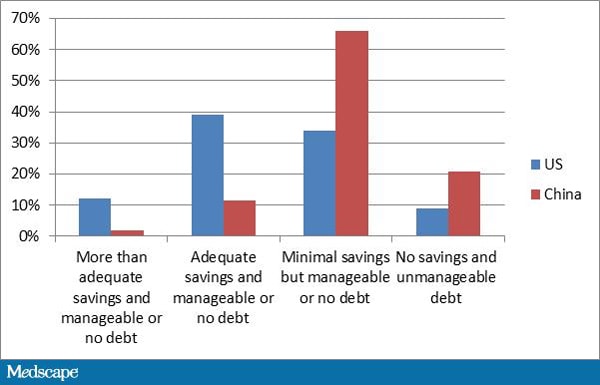
Figure 1. Savings and debt.
Patient Relationships
Difficult Patients
Chinese physicians ranked "difficult patients" high on their list of burnout causes. Changes in the healthcare system have caused deterioration in physician-patient relationships over recent decades. The most dramatic example of this is increased violence, including homicide, toward physicians by patients or their families. Negative media coverage and the belief that doctors are corrupted by pharmaceutical kickbacks have played a major role in precipitating these events.[4,5] In a previous survey of Chinese physicians, 66% reported that their hospitals encountered 1 to 3 medical disputes per month. In that survey, 78% blamed the tension between patients and physicians on the lack of government funding to hospitals, and 70% placed the blame on negative reports from the public media.[6] A recent article published in the American Journal of Medical Quality offered guidance on preventing and handling violence in hospitals.[7]
Domestic Status
When asked where they were happiest, 60.6% of Chinese physicians indicated at home, 6% at work, and a third in both places. This question was not asked in the 2013 US survey, but it did appear in the 2012 survey, where 46.1% of US physicians said that they were happiest at home, 4.3% at work, and 49.6% in both places. Both the US and the Chinese 2013 surveys requested physicians to rate their happiness at home on a scale of 1 (very unhappy) to 7 (very happy). Although the majority of Chinese physicians preferred home to work, they scored their happiness at home as only 3.4, compared with 5.5 for US physicians. Chinese physicians' mean satisfaction score at work was only slightly lower (3.3) and it was much lower than that of their US counterparts (4.8).
Chinese physicians are more likely to live alone than their US peers (27% vs 16%), which might contribute to their lower satisfaction with home life (Figure 2). They also have far fewer children (Figure 3), a rate that is not limited to this profession, given China's 32-year 1-child-only policy. (There are indications that this policy may be changing.[8])
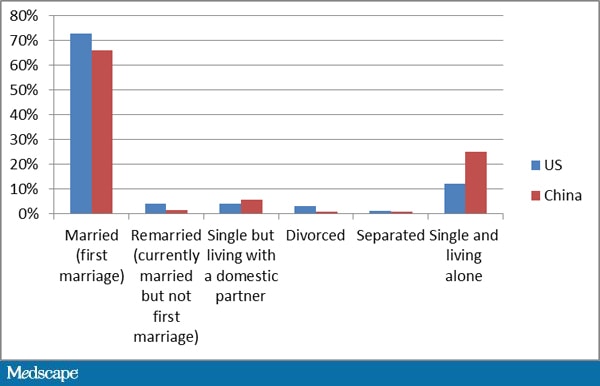
Figure 2. Domestic status.

Figure 3. Number of children.
Vacations, Volunteering, and Religiosity
Vacations
Regarding the kinds of vacations that physicians take, although the options were the same for both groups, the questions were posed differently, with US physicians able to choose as many as they wanted and Chinese physicians asked to rank their favorites. Still, it's possible to compare their preferences (Table 3) and to assume that Chinese and US physicians, with some slight differences, share the same interests.
Table 3. Vacations, Ranked From Most to Least Favorite
| United States | China |
|---|---|
| Spending time with family | Spending time with family |
| Exercise/Physical activity | Travel |
| Travel | Exercise/Physical activity |
| Reading | Reading |
| Cultural events (eg, movies, theater, museums) | Cultural events (eg, movies, theater, museums) |
| Food and wine | Surfing the Web |
| Surfing the Web | Food and wine |
| Musical activities (instrumental, vocal) | Engaging in social media (eg, discussion boards, Facebook, Twitter) |
| Gardening | Musical activities (instrumental, vocal) |
| Visual arts (eg, photography, painting, sculpture) | Visual arts (eg, photography, painting, sculpture) |
| Engaging in social media (eg, discussion boards, Facebook, Twitter) | Managing finances/investments |
| Managing finances/investments | Gardening |
| Golf | Writing (nonmedical) |
| Hunting or fishing | Collecting |
| Collecting | Hunting or fishing |
| Writing (nonmedical) | Golf |
In looking at the amount of vacation that each population takes, however, Chinese physicians fare far worse, with 64% getting less than 1 week each year, compared with 5% of US physicians (Figure 4).
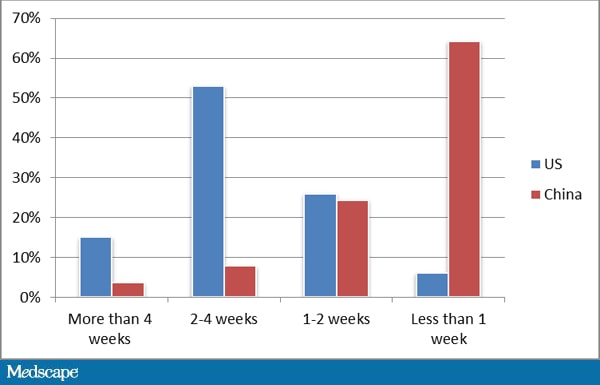
Figure 4. Amount of vacation taken by US vs Chinese physicians.
Volunteering and Religiosity
Volunteer rates are high among both US and Chinese physicians, with only 27% of US and 32% of Chinese physicians reporting that they don't volunteer at all. The type of volunteer work they do, however, differs in many ways (Figure 5). Chinese physicians are most likely to choose work that is related to their profession -- clinical work (31%) and tutoring (12%) -- rather than to personal interests. Work with religious organizations is popular among US physicians (22%) but basically nonexistent among Chinese physicians. This is not surprising considering their response to the survey question on religion, where 86.8% said that they did not have a religious or spiritual belief and 12% said that they did but did not practice. In comparison, three quarters of US physicians claimed a belief and 60% attended services.
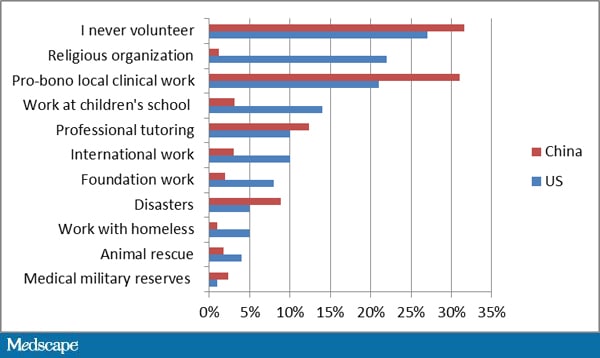
Figure 5. Types of volunteer activities.
Health and Fitness
Chinese physicians exercise far less than their US counterparts (Figure 6), which could be explained at least partly by answers on some questions that indicate how little time they have for personal activities. On causes of burnout, "too many hours at work" is ranked the number 2 stressor, and to the question about vacation, only 12% of Chinese physicians responded that they are able to take more than 2 weeks off. One can surmise that if they work all the time and take little time off, exercise is an activity that gets sacrificed.

Figure 6. How often Chinese and US physicians exercise.
Still, Chinese physicians' responses to questions on physical well-being and health were mixed. For instance, they have a lower rate of overweight (26%) or obesity (0%) compared with US physicians (31% and 6%, respectively). They also have a higher rate of underweight than their US peers (14% vs 2%), but it is not possible to know whether this indicates a healthy diet or health problems (Figure 7).
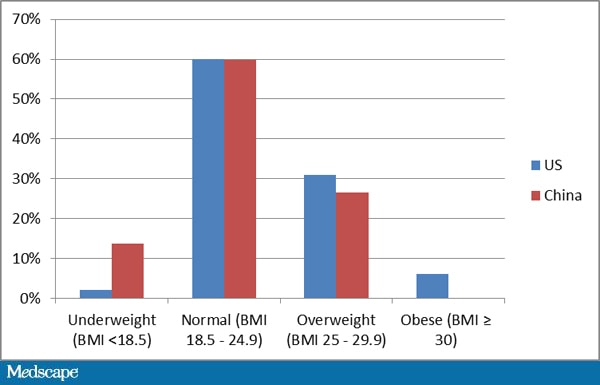
Figure 7. US and Chinese physicians' BMIs.
Chinese physicians tend to smoke a bit more than US physicians, although their rate of having never smoked is still very high (85% vs the US rate of 90%) (Figure 8).
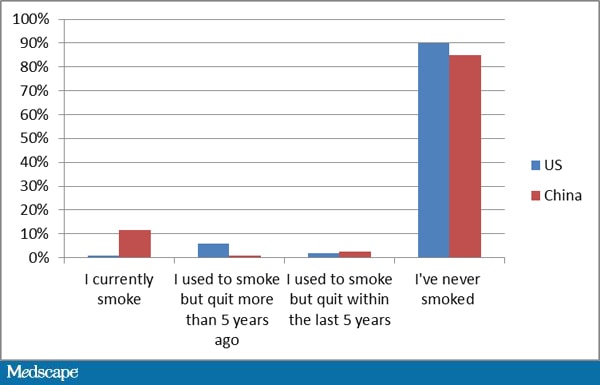
Figure 8. History of smoking.
Chinese physicians drink much less than their US peers (Figure 9): 54% do not drink at all, compared with a third of US physicians. Also, 55% have fewer than 1 drink per day, compared with 41% of their US counterparts.
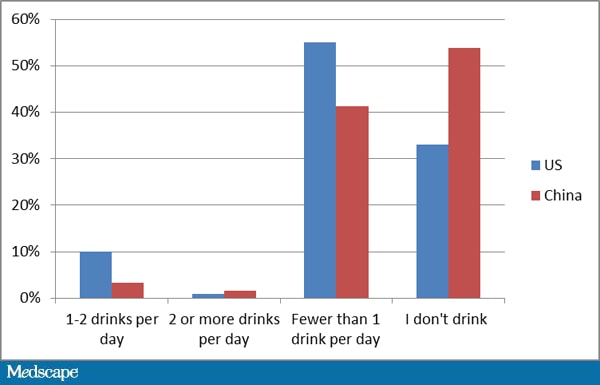
Figure 9. History of alcohol use.
Summary
A substantial percentage of both Chinese and US physicians report burnout. The problem is worse in China, however, where income levels are low and much more time is spent at work. Physician exercise levels and vacation time are very reduced in China compared with the United States, although alcohol use is low and there is less overweight and no obesity. In addition, Chinese doctors face deteriorating respect from patients and even violence directed against them, a result of higher medical costs, a negative media, and an association with pharmaceutical industry kickbacks. Various efforts are now being made in China to improve the situation, including reforming drug company reimbursement practices and undertaking experimental programs to increase income and improve care.
References
- Denoble D. Are China's doctors about to get a major bump? November 6, 2012. Asia Healthcare Blog.http://www.asiahealthcareblog.com/2012/11/06/are-chinas-doctors-about-to-get-a-major-salary-bump/ Accessed May 7, 2013.
- McGregor T. China's doctors worthy of higher pay. July 25, 2011. CRJ English.http://english.cri.cn/6909/2011/07/25/2743s650260.htm Accessed May 7, 2013.
- Yip WC, Hsiao W, Meng Q, Chen W, Sun X. Realignment of incentives for health-care providers in China. Lancet. 2010;375:1120-1130. Abstract
- [No authors listed]. Chinese doctors are under threat. Lancet. 2010;376:657. doi: 10.1016/S0140-6736(10)61315-3.http://www.thelancet.com/journals/lancet/article/PIIS0140-6736%2810%2961315-3/fulltext Accessed May 7, 2013.
- Yu D, Li T. Doctor stabbed to death two days after warning in The Lancet. Lancet. 2011;377:639. doi: 10.1016/S0140-6736(11)60231-6.
- Yu D, Li T. Facing up to the threat in China. Lancet. 2010;376:1823-1824. doi: 10.1016/S0140-6736(10)62161-7.http://www.thelancet.com/journals/lancet/article/PIIS0140-6736%2810%2962161-7/fulltext Accessed May 7, 2013.
- Feng Z, Li T. Guideline for preventing violence at hospitals in China (2011-2012). Am J Med Qual. 2013;28:169-171. doi: 10.1177/1062860612453194. Epub 2012 Aug 13.
- Alcorn T. China's new leaders cut off one-child policy at the root. 2013. Lancet. 381;983. doi:10.1016/S0140-6736(13)60697-2. http://www.thelancet.com/journals/lancet/article/PIIS0140-6736%2813%2960697-2/fulltext?rss=yesAccessed May 7, 2013.
Medscape Internal Medicine © 2013 WebMD, LLC
Cite this article: Chinese vs US Docs: Comparing Burnout and Lifestyle. Medscape. May 15, 2013.

